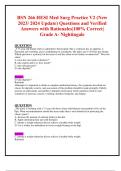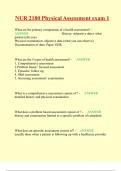BSN 266 HESI Med Surg Practic e V2 (New 2023/ 2024 Update ) Questions and Verified Answers with Rationales |100% Correct| Grade A - Nightingale QUESTION A 77 -year-old female client is admitted to the hospital. She is confused, has no appetite, is nauseated and vomiting, and is complaining of a headache. Her pulse rate is 43 beats per minute. Which question is a priority for the nurse to ask this client or her family on admission? "Does the client: A. have her own teeth or dentures?" B. take aspirin and if so, how much?" C. take nitroglycerin?" D. take digitalis?" Answer: D. take digitalis?" Rationale Although it is important to obtain a complete medication history, the symptoms described are classic for digitalis toxicity, and assessment of this problem should be made promptly. Elderly persons are particularly susceptible to digitalis intoxication whic h manifests itself in such symptoms as anorexia, nausea, vomiting, diarrhea, headache, and fatigue. QUESTION The nurse is working with a 71 -year-old obese client with bilateral osteoarthritis (OA) of the hips. What recommendation should the nurse make that is most beneficial in protecting the client's joints? A. Increase the amount of calcium intake in the diet. B. Apply alternating heat and cold therapies. C. Initiate a weight -reduction diet to achieve a healthy body weight. D. Use a walker for ambulation to lessen weight -bearing on the hips. Answer: C. Initiate a weight -reduction diet to achieve a healthy body weight. Rationale Achieving a healthy weight is critical to protect the joints of clients with OA. Weight loss for obese clients will take off the excess pressure that weight bearing joints such as the hips and knees are exposed to and reduce the wear and tear of the joints . QUESTION An elderly male client comes to the geriatric screening clinic complaining of pain in his left calf. The nurse notices a reddened area on the calf of his right leg which is warm to the touch and suspects it might be thrombophlebitis. Which type of pain wou ld further confirm this suspicion? A. Pain in the calf awakening him from a sound sleep. B. Calf pain on exertion which stops when standing in one place. C. Pain in the calf upon exertion which is relieved by rest and elevating the extremity. D. Pain upon arising in the morning which is relieved after some stretching and exercise. Answer: C. Pain in the calf upon exertion which is relieved by rest and elevating the extremity. Rationale Thrombophlebitis pain is relieved by rest and elevation of the extremity. It typically occurs with exercise at the site of the thrombus, and is aggravated by placing the extremity in a dependent position, such as standing in one place. QUESTION In preparing to administer intravenous albumin to a client following surgery, what is the priority nursing intervention? (Select all that apply.) Select all that apply A. Set the infusion pump to infuse the albumin within four hours. B. Compare the client's blood type with the label on the albumin. C. Assign a UAP to monitor blood pressure q15 minutes. D. Administer through a large gauge catheter. E. Monitor hemoglobin and hematocrit levels. F. Assess for increased bleeding after administration. Answer: A, D, E and F Rationale Albumin should be infused within four hours because it does not contain any preservatives. Any fluid remaining after four hours should be discarded. Albumin administration does not require blood typing. Vital signs should be monitored periodically to asses s for fluid volume overload. A large gauge catheter allows for fast infusion rate, which may be necessary. Hemodilution may decrease hemoglobin (HgB) and hematocrit (HCT) levels, so the HgB and HCT levels should be monitored. While monitoring for bleeding because of the increased blood volume and blood pressure. QUESTION A male client receives a local anesthetic during surgery. During the post -operative assessment, the nurse notices the client is slurring his speech. Which action should the nurse take? A. Determine the client is anxious and allow him to sleep. B. Evaluate his blood pressure, pulse, and respiratory status. C. Review the client's pre -operative history for alcohol abuse. D. Continue to monitor the client for reactivity to anesthesia. Answer: B. Evaluate his blood pressure, pulse, and respiratory status. Rationale Slurred speech in the post -operative client who received a local anesthetic is an atypical finding and may indicate neurological deficits that require further assessment, so obtaining the client's vital signs will provide information about possible cardiov ascular complications, such as stroke. QUESTION Which symptoms should the nurse expect a client to exhibit who is diagnosed with a pheochromocytoma? A. Numbness, tingling, and cramps in the extremities. B. Headache, diaphoresis, and palpitations. C. Cyanosis, fever, and classic signs of shock. D. Nausea, vomiting, and muscular weakness. Answer: B. Headache, diaphoresis, and palpitations. Rationale Pheochromocytoma is a catecholamine secreting non -cancerous tumor of the adrenal medulla, and a headache, profuse sweating and palpitations is the typical triad of symptoms depending upon the relative proportions of epinephrine and norepinephrine secretion . Surgical removal of the tumor is the only treatment. QUESTION A client with diabetes mellitus is experiencing polyphagia. Which outcome statement is the priority for this client? A. Fluid and electrolyte balance. B. Prevention of water toxicity. C. Reduced glucose in the urine. D. Adequate cellular nourishment. Answer: D. Adequate cellular nourishment. Rationale Diabetes mellitus Type 1 is characterized by hyperglycemia that precipitates glucosuria and polyuria (frequent urination), polydipsia (excessive thirst), and polyphagia (excessive hunger). Polyphagia is a consequence of cellular malnourishment when insulin deficiency prevents utilization of glucose into the cell for energy, so the outcome statement should include stabilization of adequate cellular nutrition which is done by providing the insulin supplement the client needs. QUESTION The nurse is teaching a female client about the best time to plan sexual intercourse in order to conceive. Which information should the nurse provide? A. Two weeks before menstruation. B. Vaginal mucous discharge is thick. C. Low basal temperature. D. First thing in the morning. Answer: A. Two weeks before menstruation. Rationale Ovulation typically occurs 14 days before menstruation begins during a typical 28 day cycle. Sexual intercourse should occur within 24 hours of ovulation for an increase chance of conception to occur. High estrogen levels occur during ovulation and increas e the vaginal mucous membrane characteristics to become more "slippery" and stretchy, along with a rise in basal temperature. The timing during the day is not as significant in determining conception as the day before and after ovulation. QUESTION Which intervention should the nurse plan to implement when caring for a client who has just undergone a right above -the-knee amputation? A. Maintain the residual limb on three pillows at all times. B. Place a large tourniquet at the client's bedside. C. Apply constant, direct pressure to the residual limb. D. Do not allow the client to lie in the prone position.





